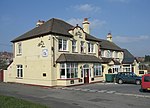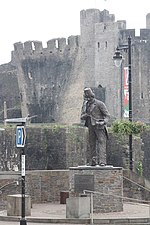Energlyn & Churchill Park railway station
2013 establishments in WalesPages with no open date in Infobox stationRailway stations in Caerphilly County BoroughRailway stations in Great Britain opened in 2013Railway stations opened by Network Rail ... and 3 more
Railway stations served by Transport for Wales RailTransport in CaerphillyUse British English from January 2017

Energlyn & Churchill Park railway station (Welsh: Eneu'r-glyn a Pharc Churchill) is a railway station in Caerphilly, Wales, on the Rhymney Line. The northbound platform is in the Energlyn suburb of Caerphilly, whilst the southbound one is in Churchill Park. The station is between Llanbradach and Aber. The first services from the station ran on 8 December 2013. The station was formally opened on 16 December 2013 by Edwina Hart, the Welsh Government Transport Minister.
Excerpt from the Wikipedia article Energlyn & Churchill Park railway station (License: CC BY-SA 3.0, Authors, Images).Energlyn & Churchill Park railway station
Lewis Drive,
Geographical coordinates (GPS) Address Nearby Places Show on map
Geographical coordinates (GPS)
| Latitude | Longitude |
|---|---|
| N 51.5838 ° | E -3.2287 ° |
Address
Lewis Drive
CF83 3RD , St Martins
Wales, United Kingdom
Open on Google Maps







